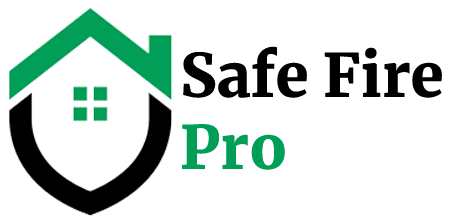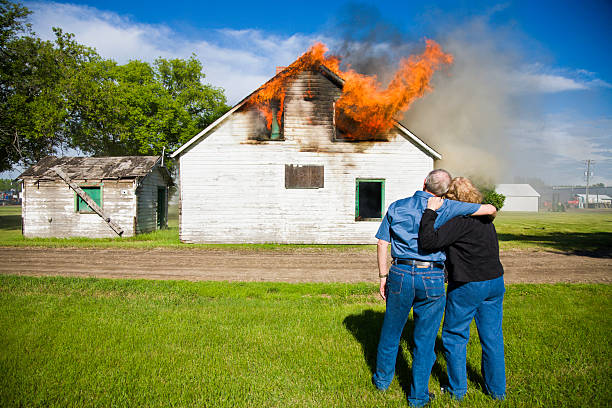Why Fire Insurance Compliance Can’t Be Ignored
Imagine pouring your life savings into a café, only to lose it all overnight in a fire. The damage itself would be heartbreaking, but what if you also discovered that your insurance claim was denied because you weren’t compliant with fire safety laws?
That’s the reality many business owners face. Fire insurance compliance isn’t just about buying a policy—it’s about following the legal and safety rules that keep your coverage valid. Governments set these rules to reduce fire risks, and insurers require them to ensure fair claims.
If you’ve ever wondered, “What does compliance actually mean for my business?” this guide breaks it down in simple, practical terms.
Background: Fire Risks and Legal Duties for Businesses
Fires don’t discriminate. They affect restaurants, warehouses, tech startups, and even home offices. According to the National Fire Protection Association (NFPA), U.S. businesses suffer billions in losses every year due to fires.
But here’s the catch: many of these losses could have been reduced—or even prevented—if fire safety compliance had been followed.
Why Compliance Matters:
-
Legal Obligation: Most countries require businesses to meet minimum fire safety and insurance standards.
-
Financial Protection: Non-compliance often leads to denied claims, leaving owners to pay losses themselves.
-
Employee Safety: Compliance saves lives by ensuring evacuation plans, alarms, and safety equipment are in place.
-
Reputation: A business that ignores safety risks loses customers and credibility.
So, compliance isn’t just about ticking legal boxes it’s about protecting your people, property, and profits.
Key Legal Requirements for Fire Insurance Compliance
Different regions have different laws, but the core compliance rules are strikingly similar worldwide. Let’s break them down:
1. Fire Safety Certificates
Most jurisdictions require a fire safety certificate issued by the local fire authority. Without it, your insurer may reject claims.
-
What it proves: Your premises meet fire safety codes.
-
How to get it: Fire department inspection of alarms, extinguishers, exits, and electrical systems.
2. Fire Risk Assessments
Business owners must conduct regular fire risk assessments. This means checking your premises for hazards and keeping records.
-
Example: A bakery identifies that flour dust and gas stoves increase fire risks. The assessment recommends extra ventilation and extinguishers.
3. Proper Installation of Fire Safety Equipment
Most laws require:
-
Smoke detectors and fire alarms.
-
Fire extinguishers on every floor.
-
Clearly marked emergency exits.
-
Sprinkler systems in high-risk industries (restaurants, warehouses).
4. Employee Training
It’s not enough to have safety tools. Employees must know how to use them. Many countries require annual fire drills and documented staff training sessions.
5. Up-to-Date Insurance Policy
Even if you follow safety rules, your coverage must match your property’s current value. Many businesses get penalized for underinsurance—when they insure property for less than its actual worth.
6. Building Code Compliance
Renovations, electrical upgrades, or illegal modifications can void fire insurance if not approved by local authorities. Always get building permits.
Fire Insurance Compliance Checklist for Business Owners
Here’s a quick-reference table you can use:
| Requirement | Why It Matters | How to Stay Compliant |
|---|---|---|
| Fire Safety Certificate | Legal proof of safety standards | Schedule regular inspections with fire authorities |
| Fire Risk Assessment | Identifies hazards before disaster strikes | Conduct annually and keep written reports |
| Safety Equipment | Ensures quick fire detection & control | Install alarms, extinguishers, sprinklers; test monthly |
| Employee Training | Saves lives during emergencies | Hold yearly fire drills and record attendance |
| Insurance Policy Updates | Prevents claim denials | Adjust coverage after renovations or equipment upgrades |
| Building Code Compliance | Avoids policy voidance | Get permits for changes and electrical work |
Real Story: How Compliance Saved a Small Business
Let me share a true-to-life style example.
A small bakery in Boston experienced an oven fire that spread to the storeroom. Damages totaled nearly $150,000. The owner feared financial ruin—but because they had:
-
An up-to-date fire safety certificate.
-
Records of employee fire drills.
-
Correctly valued insurance coverage.
…the insurer processed the claim within weeks.
Had the bakery skipped compliance, the payout might have been denied. Instead, the bakery reopened stronger, adding a new café area thanks to the insurance payout.
The lesson? Compliance isn’t just paperwork—it’s the reason some businesses survive fires while others shut down.
FAQs
Q: Do small businesses really need fire risk assessments?
Yes. Even a small shop must prove compliance if it wants claims honored.
Q: Can insurers deny a claim for missing a fire drill?
In some jurisdictions, yes—especially if the lack of training worsened damages or injuries.
Q: Is compliance the same worldwide?
No. Local fire codes differ, but the basics (certificates, equipment, training) are universal.
The Future of Fire Insurance Compliance
The world of business is changing fast—and so are the rules around fire safety and insurance. What was considered “good enough” a decade ago might not pass inspections today. Let’s look at where fire insurance compliance is headed.
1. AI-Powered Risk Monitoring
Insurers are already using artificial intelligence to detect fraud and speed up claims. Soon, AI will also monitor compliance. Imagine systems that:
-
Track whether fire extinguishers were serviced on time.
-
Send alerts if evacuation routes are blocked.
-
Flag policyholders who skip required inspections.
This creates continuous compliance instead of just annual checkups.
2. IoT and Smart Devices
The Internet of Things (IoT) is reshaping compliance. Businesses are adopting:
-
Smart smoke detectors that send data to insurers.
-
IoT-enabled sprinklers that test themselves.
-
Sensors in warehouses that monitor heat, humidity, and potential hazards.
These devices reduce human error and help prove compliance when making claims.
3. Digital Compliance Records
Paper checklists are fading. Insurers and regulators are moving toward digital compliance logs, stored securely in the cloud. These allow:
-
Instant proof of inspections.
-
Easier audits.
-
Faster claim approvals.
4. Stricter Climate-Driven Regulations
With rising wildfires and urban density, governments are enforcing stricter building codes and insurance requirements. Businesses in high-risk zones may need special coverage or advanced fire suppression just to operate.
5. Integration With ESG (Environmental, Social, Governance) Goals
Investors and insurers are linking fire safety compliance with sustainability and corporate responsibility. For example, businesses that adopt eco-friendly fire systems may get lower premiums.
Ethical and Legal Challenges in Compliance
With technology and stricter rules come new challenges.
1. Data Privacy
IoT compliance devices collect sensitive data. Who owns this information—you, the insurer, or the device manufacturer? Business owners must demand transparent data policies.
2. Unequal Access
Small businesses may struggle to afford advanced compliance tech. Regulators need to ensure compliance doesn’t become a burden that only big corporations can meet.
3. False Sense of Security
Smart devices help, but they aren’t foolproof. Over-reliance on tech could lead to negligence in basic human-driven safety measures like staff training.
4. Legal Liability
If compliance systems fail, who’s responsible—the business owner, the insurer, or the tech provider? Courts are still debating these issues, making it critical for business owners to read contracts carefully.
Step-by-Step Fire Insurance Compliance Roadmap
Here’s a practical roadmap any business owner can follow:
Step 1: Assess Risks
-
Identify fire hazards unique to your industry.
-
Document them in a risk assessment report.
Step 2: Get Certified
-
Apply for a fire safety certificate from the local authorities.
-
Schedule regular inspections to keep it valid.
Step 3: Install and Maintain Equipment
-
Smoke detectors, alarms, extinguishers, sprinklers.
-
Test equipment monthly and log results.
Step 4: Train Employees
-
Hold annual fire drills.
-
Keep attendance records as proof.
Step 5: Update Insurance Regularly
-
After expansions, renovations, or equipment purchases.
-
Avoid underinsurance by reviewing policy values yearly.
Step 6: Keep Records Digital
-
Save certificates, inspection reports, and training logs in the cloud.
-
Share access with insurers to speed up claims.
Step 7: Audit Yourself
-
Perform an internal compliance check every 6–12 months.
-
Correct small issues before inspectors—or insurers—find them.
Quick Compliance Roadmap Table
| Step | Action | Proof Needed |
|---|---|---|
| Risk Assessment | Identify and document hazards | Written assessment report |
| Certification | Obtain fire safety certificate | Valid certificate from fire authorities |
| Equipment Maintenance | Test and service safety devices | Service receipts, inspection logs |
| Employee Training | Conduct fire drills | Attendance records, training manuals |
| Insurance Updates | Adjust policy after changes | Updated insurance documents |
| Record Keeping | Store compliance logs digitally | Cloud records, digital files |
| Internal Audit | Review compliance every 6–12 months | Audit checklist and corrections |
Real Story: Compliance Roadmap in Action
A medium-sized IT company in Singapore followed this roadmap to the letter. When a server fire caused $250,000 in damages, the insurer processed the claim in just three weeks because the business had:
-
Digital compliance logs.
-
Proof of regular equipment checks.
-
Employee training documentation.
In contrast, a similar firm nearby had no records of fire drills or risk assessments. Their claim took over six months—and was reduced due to partial non-compliance.
Compliance doesn’t just protect legally—it speeds up recovery when disaster strikes.
FAQs: Future and Compliance
Q: Will future compliance be harder for small businesses?
Possibly, but insurers are already offering affordable IoT devices and bundled compliance packages to make it easier.
Q: Can AI really ensure compliance?
AI can monitor patterns and alert owners to gaps, but human oversight will always be necessary.
Q: What if my business is fully compliant but the insurer still delays payment?
Having digital proof of compliance gives you leverage to challenge delays legally or through ombudsman services.
References
-
Industrial Fire Safety Compliance – Superior Industrial Fire Services gives an overview of how businesses maintain compliance with fire safety laws, codes, and standards. Superior Industrial Fire Service
-
Fire Safety Regulations for Businesses – Forbel (security solutions provider) explains common U.S. fire safety regulations, NFPA codes, and business obligations. forbel.com
-
Understanding Fire Safety Regulations – Fire Safety article breaking down building codes, fire detection, suppression systems, and regulatory compliance basics. Fire Safety and Protection
-
What Every Business Owner Needs to Know About Fire Safety – TBFRM describes how proper fire risk assessments help satisfy legal requirements and reduce hazards. tbfrm.com
-
What Types of Fire-Related Losses a Business Can Recover – Barrett Law covers legal / insurance perspectives on claims, business interruption, ordinance compliance, etc. barrettlawpllc.com
-
Code of Virginia: Fire Insurance Policies – Gives a statutory example of how a U.S. state regulates fire insurance contracts, including terms, exclusions, and policy standards. Virginia Law
-
Public Protection Classification (PPC) Program – ISO’s system for rating fire protection services in communities, which affects insurer risk assessments. Wikipedia
-
Life Safety Code (NFPA 101) – A major standard used in many jurisdictions to regulate building design, emergency exits, and fire safety systems.

